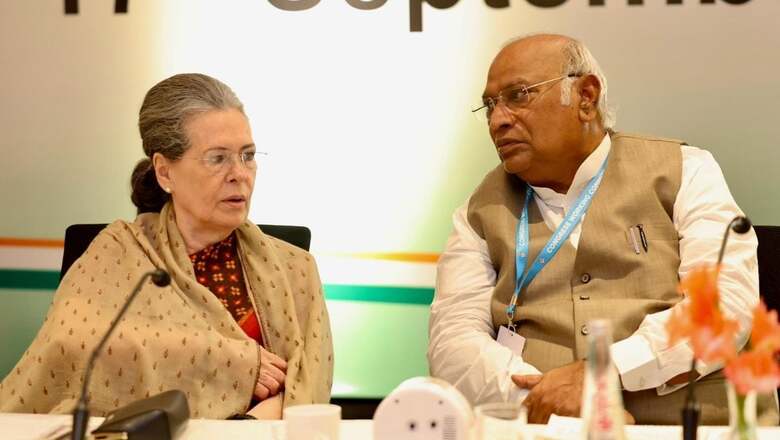
views
The Congress leadership will boycott the Ram Mandir’s ‘Pran Pratishtha’ ceremony in Ayodhya on January 22. The Ram Janmabhoomi Teerth Kshetra Trust had invited Congress leaders Sonia Gandhi, Mallikarjun Kharge and Adhir Ranjan Chowdhury for the event. The party leadership, after deliberating over the issue for over a week, has finally decided to officially give it a miss.
The Congress leadership believes that while “religion is a personal matter”, the January 22 ceremony is a “BJP-RSS event”.
Interestingly, when one looks at the Congress’ history, its stand on matters of religion has largely been opportunistic, if not dubious. From overturning the Supreme Court’s Shah Bano judgement to providing Haj subsidy, disbursing monthly salaries to Muslim clerics, and legitimising the Islamist endeavour to turn the entire country into a Waqf land through the Waqf Act of 1995, the party has often been seen to be hand in glove with fundamentalist elements.
The grand old party’s role in controlling and misappropriating Hindu temples in the name of their management too calls its ‘secular’ bluff. Though other political parties have hardly fared any better on the issue, the role of Congress, being in power for the longest time, gets magnified the most. If Anand Ranganathan’s book Hindus in Hindu Rashtra is to be believed, “Governments of just 10 states control more than 1,10,000 temples.” Of these, the DMK-led Tamil Nadu government, of which the Congress is an alliance partner in the state, alone controls 36,425 temples and 56 mutts. For Karnataka, a state again run by the Congress, the figure is 34,563!
So much for the Congress’ “religion is personal” remark!
One could still have forgiven the party for its endeavour to take away temple freedom, had it helped the cause of the nation. According to TR Ramesh, who has been fighting for temple liberation in Tamil Nadu for decades now, the Tamil Nadu government, which should be earning “a minimum of Rs 6,000 crore per annum from the 2.44 crore square feet of temple land it controls, earns a mere Rs 58 crore”. This is not even 1 per cent of the income it should be earning from the acquired temple land in Tamil Nadu!
As for the January 22 ceremony being a “BJP-RSS event”, it is far from true. The Ram Janmabhoomi Teerth Kshetra Trust, which is organising the Pran Pratishtha event, was set up by the Union government on the orders of the Supreme Court. The grand temple is also being constructed on donations from Hindus, and not public funds.
This brings us to the larger question: Why is the Congress leadership uncomfortable with the idea of visiting the Ram temple in Ayodhya? Here, it needs to be reiterated that it’s not the party per se but its dynastic leadership, the Gandhi-Nehru to be precise, that has been uncomfortable with the Ram Mandir. Today, when Sonia Gandhi and her son, Rahul, showcase their distrust for the Ram temple, they simply betray the Nehruvian misgivings about temples in general, and the Ram temple in particular.
On December 26, 1949, three days after when an idol of Ram Lalla had mysteriously appeared at the then disputed Ramjanmabhoomi site, Nehru sent a telegram to then chief minister GB Pant, saying he was “disturbed at developments at Ayodhya”. He also sent a letter a few months later, accusing the “District Officer in Fyzabad” of taking “no steps to prevent this happening”.
However, it is the Somnath saga that truly exposes the anti-temple Nehruvian mindset. It’s well-known how Nehru had accused KM Munshi of stocking “Hindu revivalism” when the latter pushed for the reconstruction-cum-renovation of the Somnath temple. What is not quite known is that the idea to reconstruct the Somnath temple had the Cabinet approval; Nehru, in fact, had presided over the cabinet meeting in which this decision was taken. He, however, took a U-turn after the death of Sardar Patel on 15 December 1950. Mahatma Gandhi, the other votary of Somnath temple, was already dead by then.
After Patel’s death, Nehru became increasingly hostile not just to the temple project, but also to cabinet colleagues, especially Munshi and VN Gadgil, who were associated with the Somnath temple project. It was at that moment that Nehru wrote the ‘Hindu revivalism’ letter to munshi, saying: “I don’t like your trying to restore Somnath. It is Hindu revivalism.”
To this Munshi replied, on April 24, 1951, strongly rebutting Nehru’s claims. The letter, which is now available in Munshi’s book Pilgrimage to Freedom, reads thus:
“On 13 December 1947, the Standing Committee of the W.M.P. Ministry accepted (VN) Gadgil’s proposal that the Government of India should reconstruct the temple in the original form and develop roughly one square mile of the surrounding area… At the time, the decision of the Government was that the W.M.P. Ministry should reconstruct the old shrines and they were doing so in the case of certain Muslim shrines and mosques.”
“The Government of India, thereafter, deputed Government architects to visit Prabhas and prepare a report for the reconstruction of the temple.”
“When the whole scheme was discussed by Sardar with Bapu, he stated that it was alright except that the funds necessary for re-constructing the temple should come from the public. Gadgil also saw Bapu and Bapu gave him the same advice. Thereafter, the idea that the Government of India should finance the reconstruction of the temple was given up…”
“As you will see, the Government of India not only took the initial decision to reconstruct the temple, but formulated and set the scheme going; alongside creating the agency for its further implementation. This will clearly indicate to you the extent of association the Government of India has with the scheme…”
“Yesterday, you referred to ‘Hindu revivalism.’ It is my faith in our past which has given me the strength to work in the present and look forward to our future.”
The Congress’ distrust for temples, especially the Ram Mandir, is thus age-old but one confined largely to the Gandhi-Nehru family. The Congress, in that way, seems to be a victim of its own dynastism which has pushed it to take an anti-temple posturing even when most of its members have largely been sympathetic to the issue. It happened in the 1950s when soon after Patel’s death the Congress was totally hijacked by Nehru and his acolytes. It’s happening today as well, seven decades down the line, when the mother-son duo of the family decides to push the party to extreme left, reportedly on the advice of a communist leader whose name invokes both Ram and Sita.
Be that as it may, the decision to boycott the Ram Mandir ceremony on January 22 will count among the most indiscreet and ill-advised decisions of the Congress leadership in recent times. It was a great chance for the party to do away with its anti-Hindu image. Ram is the sublime manifestation of the idea of civilisational Bharat. The Congress, by refusing to resort to course correction, has squandered a great opportunity to align itself with this country’s civilisational core, thus setting the course for its further marginalisation — politically and otherwise.
Views expressed in the above piece are personal and solely those of the author. They do not necessarily reflect News18’s views.


















Comments
0 comment